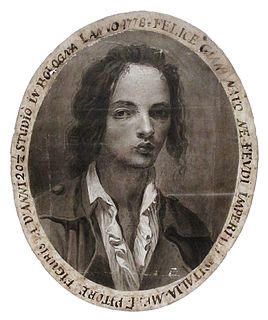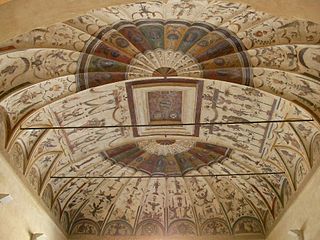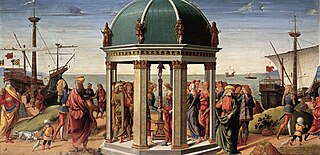Related Research Articles

Ferraù Fenzoni was an Italian painter and draughtsman. He was a canvas and fresco painter of biblical and religious subjects who worked in a late Mannerist style. He trained and worked in Rome in his youth and later he worked on important commissions in Todi and his native Faenza. He is also called 'Ferraù da Faenza' and 'Il Faenzone' after his birthplace Faenza.

Felice Giani was an Italian painter of the Neoclassic style. His grand manner subjects often included Greco-Roman allusions or themes.

Vittorio Bigari was an Italian painter of the late-Baroque period.
Events from the year 1699 in art.

Girolamo da Treviso, also known as Girolamo di Tommaso da Treviso the Younger and Girolamo Trevigi, was an Italian Renaissance sculptor and painter in Henry VIII's court in England.

Marco Marchetti was an Italian painter of the late-Renaissance or Mannerist period. Born in Faenza, he is also known as Marco da Faenza. He painted an Adoration by the shepherds (1567) originally in the church of the confraternity of Santa Maria dell'Angelo, but now in the pinacoteca of Faenza. He also painted along with Giorgio Vasari a series of frescoes in the Palazzo Vecchio representing the Life of Hercules. He painted an altarpiece representing the Martyrdom of St. Catherine of Alexandria (1580) in the church of Sant'Antonio in Faenza.

Jacopo Bertucci was an Italian painter of the Renaissance period. He is also known as Jacopone da Faenza. He was born in Faenza, and worked under Raphael in Rome. One of his pupils was Taddeo Zuccari. He was active c. 1530 and painted in the manner of Raphael. He painted for the church of San Vitale at Ravenna. He died at the age of 20.
Giovanni Battista Ballanti (1762–1835), also known as Giovan Battista Ballanti Graziani, was an Italian sculptor working in the Neoclassic style.

Biagio d’Antonio Tucci was an Italian Renaissance painter active in Florence, Faenza and Rome.

Francesco da Cotignola, also called Zaganelli, was an Italian painter of the Renaissance period, active mainly in Parma and Ravenna.
Giulio Tonduzzi was an Italian painter of the Renaissance period.

Franco Gentilini was an Italian painter.
Ottaviano da Faenza, an Italian painter of the 14th century, who was instructed by Giotto, spent the greater part of his life at Faenza, where he died. There are several paintings attributed to him to be found in the neighbourhood of Faenza, and at Bologna.

Pace di Bartolo or Pace da Faenza was an Italian painter, active in Assisi in 1344-1368.
Sigismondo Foschi, also called Sigismondo da Faenza was an Italian painter of the Renaissance period, born and active in Faenza. He was likely a pupil of Giovanni Antonio Sogliani.

Tommaso Minardi was an Italian painter and author on art theory, active in Faenza, Rome, Perugia, and other towns. He painted in styles that transitioned from Neoclassicism to Romanticism.

Antonio Berti was an Italian painter, mainly portraits, landscapes, and romantic scenes.
Niccolò Paganelli was an Italian painter of the late-Renaissance period.

Tommaso Dal Pozzo, also known as Tomaso Dalpozzo was an Italian painter and ceramist, mainly depicting landscapes and genre scenes.
Pasquale Saviotti (1792–1855) was an Italian painter and engraver who worked in a Neoclassical style.
References
- Farquhar, Maria (1855). Ralph Nicholson Wornum (ed.). Biographical catalogue of the principal Italian painters. London: Woodfall & Kinder. p. 106.